Understanding the Safety Concerns Around Amber Jewelry
Are amber bracelets safe is a question that has gained significant urgency as these fossilized resin accessories have surged in popularity, particularly among parents seeking natural teething remedies for their infants. While amber jewelry has been marketed with claims of pain relief and healing properties, mounting evidence from health organizations paints a concerning picture of serious risks.
Quick Answer:
- For infants and children under 3: No - major health organizations including the FDA and American Academy of Pediatrics strongly advise against amber jewelry due to choking, strangulation, and infection risks
- For adults: Generally safe when properly fitted and made from authentic materials
- Scientific evidence: No credible research supports claims that amber releases healing compounds at body temperature
- Bottom line: Risks far outweigh any unproven benefits, especially for young children
The popularity of amber teething jewelry has been fueled by social media trends and anecdotal testimonials from parents desperate to soothe their teething babies naturally. However, the FDA has received reports of deaths and serious injuries related to these products, with suffocation being the leading cause of death for children under one year old.
As Gabriel Ciupek, President and owner of Midwest Amber with years of experience in the Baltic amber industry, I've witnessed how questions about are amber bracelets safe have become increasingly critical as parents seek authentic information about these products. My background in amber jewelry has given me unique insight into both the quality aspects of genuine amber and the important safety considerations that every consumer should understand.
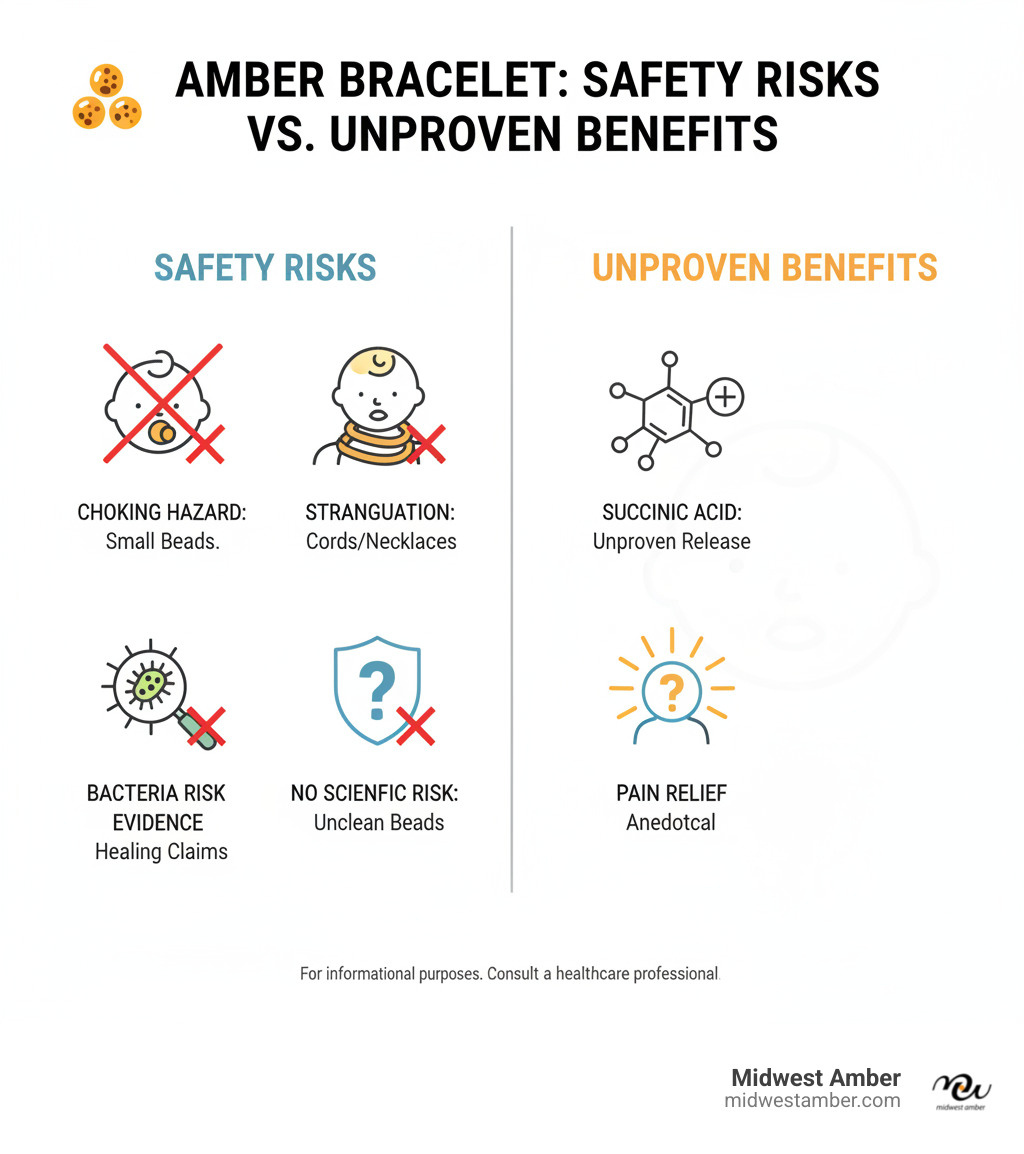
What Are Amber Bracelets and Their Purported Benefits?
Amber bracelets, particularly those marketed for infants, are typically made from Baltic amber. The Gemological Institute of America (GIA) defines Baltic amber as "a fossilized resin that originates from tree and plant sources, thousands of years ago, from regions around the Baltic Sea." It's a natural, organic material that has fascinated humanity for millennia, often prized for its warm hues and inclusions of ancient life.
For infants, amber bracelets are often marketed as a "natural" solution for teething pain. Proponents claim that when amber comes into contact with warm skin, it releases succinic acid, a substance believed to possess anti-inflammatory and analgesic (pain-relieving) properties. These purported benefits include soothing sore gums, reducing fussiness, and even boosting the immune system. Many parents, eager to avoid pharmaceutical interventions, are drawn to these claims, viewing amber bracelets as a gentle, holistic approach to a baby's discomfort. It's often presented as a traditional remedy, tapping into a desire for natural healing methods.
At Midwest Amber, we pride ourselves on offering 100% natural, ethically sourced amber from Poland and Lithuania, backed by over 20 years of experience and certified authenticity. While we cherish the beauty and heritage of genuine Baltic amber, we also believe in providing clear, evidence-based information about its use. For those interested in understanding the nuances of authentic amber jewelry, we've prepared a comprehensive guide: More info about authentic amber jewelry.
The Science Behind the Claims
The core of the "healing" claims surrounding amber bracelets revolves around succinic acid. This organic compound is naturally present in amber (typically 3-8% in Baltic amber) and, ironically, is also found in nearly every cell in the human body, playing a role in the metabolic process. The theory is that when a baby wears an amber bracelet, their body heat warms the amber, causing it to release microscopic amounts of succinic acid, which is then absorbed through the skin into the bloodstream, providing its therapeutic effects.
However, scientific scrutiny tells a different story. Research has consistently shown a significant lack of evidence to support these claims. For succinic acid to be released from Baltic amber, it needs to be heated to temperatures far exceeding human body temperature—around 200 degrees Celsius (392 degrees Fahrenheit). A baby's skin temperature, typically 36-37 degrees Celsius, is simply not hot enough to trigger such a release. Furthermore, even if succinic acid were released, there's no scientific proof that it can be absorbed through the skin in a way that would produce any systemic pain-relieving or anti-inflammatory effects. A study published in BMC Complementary and Alternative Medicine examined this very question, noting the conditions required for succinic acid leaching from beads. You can explore this further in the Scientific research on succinic acid from amber.
Many medical and dental professionals conclude that any perceived benefits from amber teething jewelry are likely due to a placebo effect, or simply the natural progression of teething symptoms, which often come and go. When symptoms miraculously disappear after putting on a bracelet, it's easy to attribute it to the amber, even if coincidence is the true cause.
Why They Are Popular for Teething
Despite the lack of scientific backing, amber bracelets and necklaces remain incredibly popular for teething infants. This popularity stems from several factors:
- Parental desire for natural remedies: Many parents prefer to avoid over-the-counter medications for their babies when possible. The idea of a "natural" solution is very appealing.
- Social media trends and anecdotal testimonials: Social media platforms are rife with parents sharing their positive experiences, often accompanied by adorable pictures of their babies wearing amber. These anecdotal accounts, while heartfelt, can create a powerful, persuasive narrative that overshadows scientific skepticism. As one research article noted, the marketing of amber necklaces is often boosted by social media and influencers without proper data legitimation.
- Perceived as a gentle alternative: Compared to gels, medicines, or even hard plastic teethers, amber jewelry might seem like a passive, gentle option. The aesthetic appeal also plays a role, with many parents finding the beads charming.
We understand the emotional pull of wanting the best, most natural care for your little ones. However, as we'll explore, the perceived gentleness of amber jewelry for infants masks very real, very serious dangers.
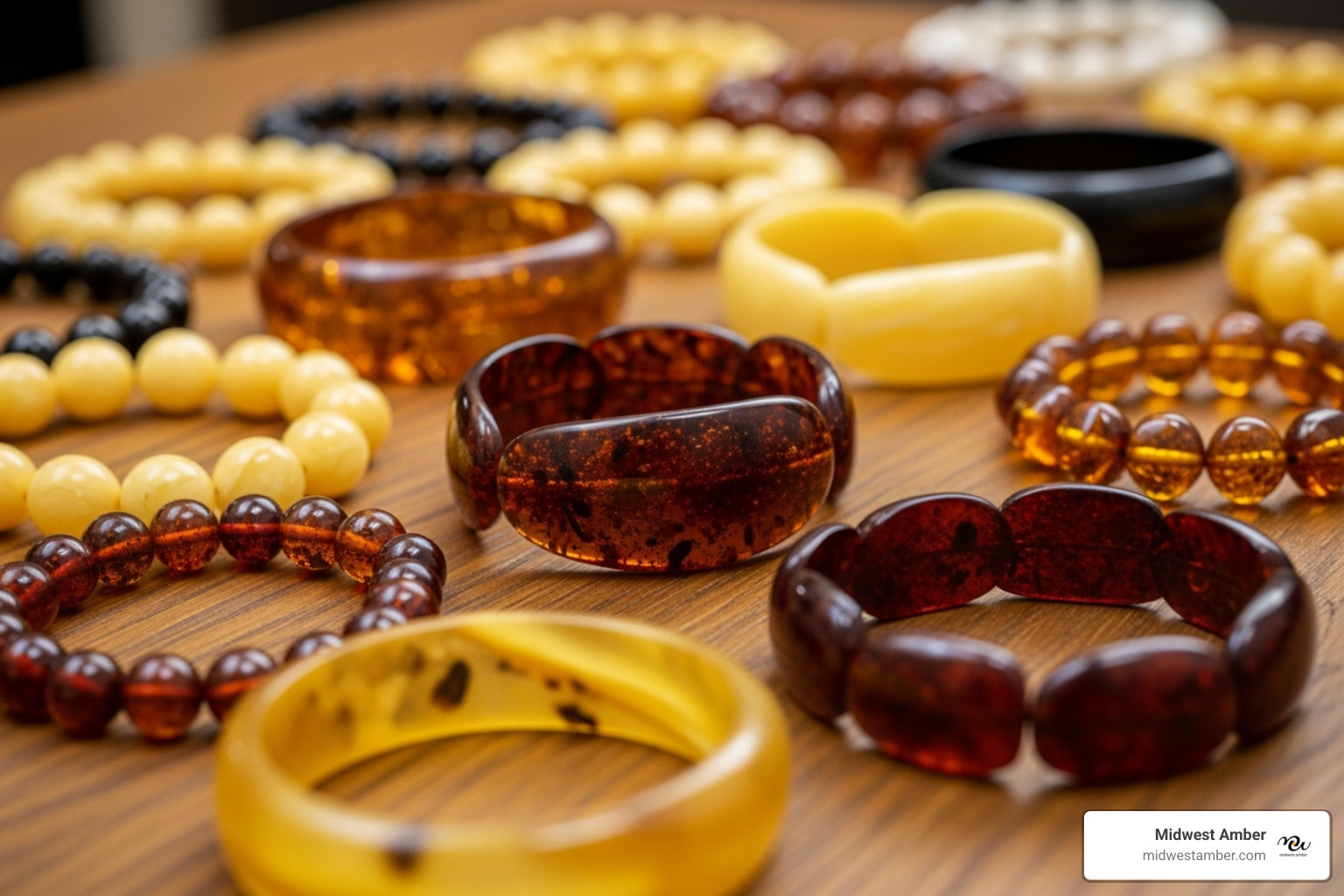
Are Amber Bracelets Safe? A Look at the Documented Risks
When parents ask "are amber bracelets safe" for their babies, the answer from medical experts is clear and unwavering: absolutely not. This isn't a matter of being overly cautious—it's based on real tragedies and documented evidence from major health organizations worldwide.
The U.S. Food and Drug Administration has received heartbreaking reports of infant deaths and serious injuries directly linked to teething jewelry, including amber bracelets and necklaces. These aren't isolated incidents or theoretical risks. Real families have lost their babies to strangulation and choking caused by these products.
The statistics paint a sobering picture. Suffocation remains the leading cause of death for children under one year old and ranks among the top five causes for children aged 1 to 4. When we consider that amber jewelry adds unnecessary risk to these already vulnerable age groups, the math becomes frighteningly simple.
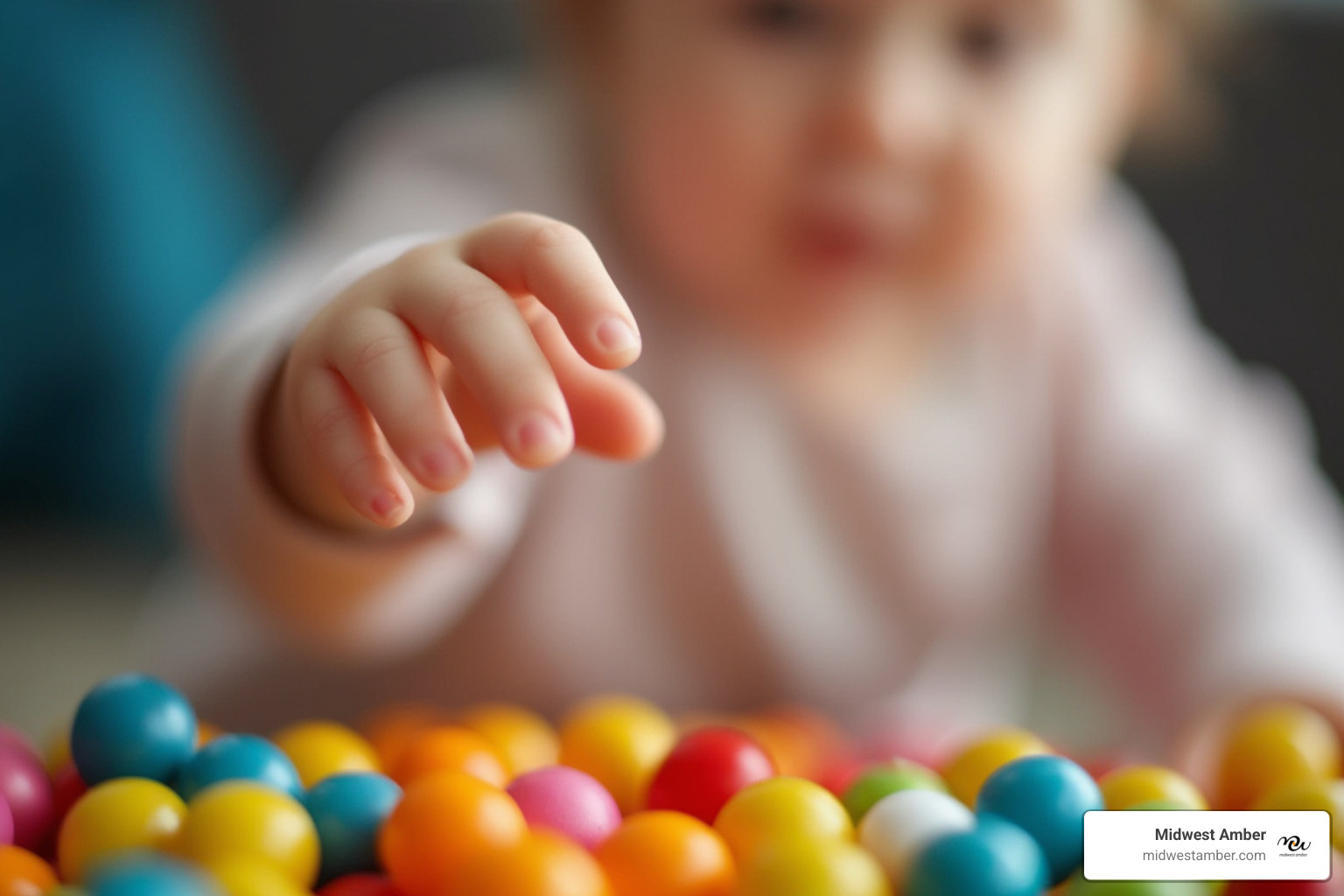
What makes this even more concerning is that these products routinely fail basic safety standards. Testing under EU Toy Safety Regulations shows that amber teething jewelry often doesn't meet requirements for size, tension, and impact—particularly because their small parts pose hazards for children under three who naturally explore the world by putting things in their mouths.
Choking and Strangulation Hazards for Infants
The dangers of amber jewelry for babies are immediate and life-threatening. Let me walk you through what can go wrong, because understanding these risks could save a life.
Choking happens faster than you might think. Individual amber beads are perfectly sized to block a baby's airway. Even products claiming to have "safety knots" between each bead can't prevent this danger entirely. When testing revealed that some amber necklaces required 15 pounds of force to break while others snapped at just 1.6 pounds, it became clear there's no consistency in these products.
This inconsistency creates a double danger. A bracelet that's too strong won't break away if caught on something, leading to strangulation. But one that breaks too easily scatters choking hazards across your baby's reach.
Strangulation can occur silently and quickly. The FDA documented the tragic death of an 18-month-old who was strangled by an amber necklace during a nap. This wasn't during rough play or unsupervised time—it happened during what should have been a safe moment of rest.
Any cord around a baby's neck poses this risk, especially during sleep, when jewelry can catch on crib slats, blankets, or even the child's own movements. Babies are naturally active sleepers, and what seems secure when awake can become deadly when they're moving unconsciously.
The American Academy of Pediatrics doesn't mince words on this topic. They state clearly: "The AAP does not recommend that infants wear any jewelry." Their comprehensive warning explains why even well-meaning parents should avoid these products entirely. You can read their full guidance at The American Academy of Pediatrics' warning on teething necklaces.
Infection and Other Hidden Dangers
Beyond the immediate life-threatening risks, amber jewelry poses subtler but serious health concerns that many parents never consider.
Bacterial colonization is a hidden danger that develops over time. Research has identified 32 different bacterial species thriving on amber necklaces, with harmful staphylococci being particularly common. Think about it—these beads sit against your baby's skin, collect saliva when chewed, and rarely get properly cleaned. They become perfect breeding grounds for bacteria.
This bacterial buildup can cause skin infections, rashes, and mouth infections—particularly dangerous for babies whose immune systems are still developing. When teething already makes gums tender and sometimes creates small irritations, introducing bacteria-laden beads into the mix is asking for trouble.
There's also an ironic twist to the succinic acid claims. While marketers tout this compound as beneficial, material safety data sheets actually classify succinic acid as potentially hazardous upon skin contact, listing it as an irritant. So even if the healing claims were true (which they're not), the substance could theoretically cause irritation rather than relief.
Physical injury to developing mouths is another concern often overlooked. Hard amber beads can damage delicate gums and emerging teeth when babies chew on them. What's marketed as soothing could actually be causing additional discomfort.
At Midwest Amber, we've spent over 20 years working with genuine Baltic amber, and we understand both its beauty and its appropriate uses. When parents ask us "are amber bracelets safe" for their babies, we always prioritize safety over sales. The evidence is simply too overwhelming to ignore—these products pose serious risks to the most precious members of your family.
What Major Health Organizations Say
When it comes to the question are amber bracelets safe for babies and young children, the medical community speaks with one unified voice: absolutely not. This isn't a matter of differing opinions or cautious recommendations—it's a clear, evidence-based warning from the organizations we trust most with our children's health.
The American Academy of Pediatrics (AAP) takes a firm stance against amber teething jewelry. They don't mince words: "The AAP does not recommend that infants wear any jewelry." Period. Their reasoning is straightforward and sobering—suffocation remains the leading cause of death for babies under one year old, and jewelry of any kind introduces unnecessary risk. The AAP emphasizes that there's simply no scientific evidence supporting the claimed benefits of amber jewelry, making the risk-to-benefit ratio completely unacceptable.
The U.S. Food and Drug Administration (FDA) stepped up with an official warning in December 2018, and their message was equally direct. They've received actual reports of deaths and serious injuries from teething jewelry, including heartbreaking cases of strangulation and choking. These aren't theoretical risks—they're real tragedies that have happened to real families. The FDA's warning specifically addresses both pain relief claims and sensory stimulation uses, making it clear that no perceived benefit justifies the danger. You can read their complete statement in the FDA 2018 media release on teething jewelry risks.
This concern extends far beyond U.S. borders. Consumer protection agencies worldwide have taken similar stances. In Ireland, for example, the Competition and Consumer Protection Commission considers amber teething jewelry inherently unsafe and actively works to remove these products from retail shelves. They even encourage people to report retailers who continue selling them.
What makes these warnings so powerful is their consistency. These organizations don't always agree on everything, but when it comes to amber teething jewelry, the message is remarkably unified across different countries, specialties, and regulatory bodies.
Safer, Recommended Approaches for Teething Pain
I get it—watching your little one struggle with teething pain is heartbreaking. As parents, we want to do something, anything, to help. The good news is that pediatricians have plenty of safe, effective strategies that actually work without putting your baby at risk.
Gentle gum massage often provides immediate relief. Using a clean finger, you can gently rub your baby's sore gums. The pressure feels good to them, and the skin-to-skin contact is comforting. Many babies find this more soothing than any product you could buy.
Safe teething toys are your best friends during this phase. Look for firm rubber or silicone teething rings that are too large to pose a choking hazard—if it fits entirely through a toilet paper roll, it's too small. Avoid liquid-filled teething toys since they can break and leak.
Cool relief can work wonders, but keep it reasonable. A clean, cool washcloth gives babies something safe to chew on. You can also offer a chilled (not frozen) pacifier or teething toy. Skip anything frozen solid—it's too hard and can actually hurt those tender gums.
Sometimes the best medicine is simply extra comfort and cuddles. A cranky teething baby often just needs more reassurance that you're there. Rock them, sing to them, or try a warm bath to help them relax.
Always consult your pediatrician if you're concerned. If your baby has a fever over 100.4°F, excessive diarrhea, or seems unusually unwell, call your doctor. While teething can cause mild discomfort, it shouldn't cause high fevers or serious illness. Your pediatrician can recommend appropriate pain relief if needed—and importantly, they'll tell you to avoid numbing gels containing benzocaine, which can be dangerous for infants.
For comprehensive guidance on managing teething discomfort safely, the Mayo Clinic offers excellent evidence-based advice: Tips for soothing sore gums from Mayo Clinic.
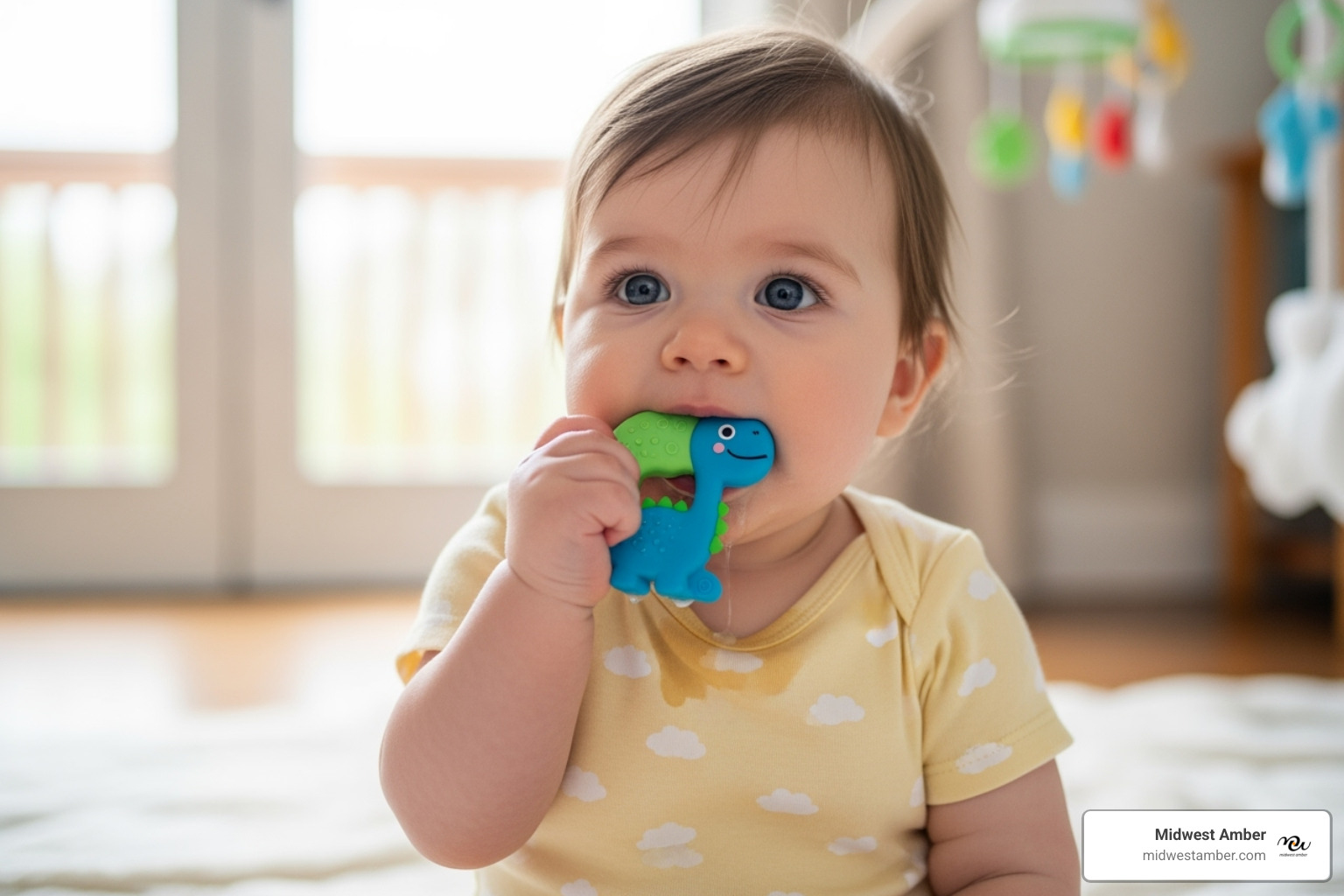
For Adults Wondering 'Are Amber Bracelets Safe?'
Now, if you're an adult asking are amber bracelets safe for yourself, that's an entirely different conversation. The choking and strangulation risks that make these pieces so dangerous for babies simply don't apply to grown-ups. We're not putting jewelry in our mouths, and we can manage potential snagging situations that might catch a toddler off-guard.
For adults, amber bracelet safety really comes down to quality and authenticity. At Midwest Amber, we've spent over 20 years perfecting our understanding of genuine Baltic amber. Our pieces are 100% natural and ethically sourced from Poland and Lithuania, with certified authenticity so you know exactly what you're getting. When you're dealing with genuine, high-quality amber, the safety concerns shift to more typical jewelry considerations.
Proper fit matters for comfort and safety. Your amber bracelet should feel comfortable—not tight enough to restrict circulation or cause skin irritation, but not so loose that it slides around excessively or could easily snag on things. A well-fitted bracelet becomes part of your daily routine without causing problems.
Good craftsmanship makes a real difference in both safety and longevity. Look for securely strung beads and robust clasps that won't break during normal wear. This is where buying from experienced, reputable sources becomes important.
Care and maintenance will keep your amber looking beautiful and functioning safely for years. Avoid harsh chemicals, extreme temperatures, and prolonged water exposure. Treat your amber jewelry with the same respect you'd give any cherished accessory.
For adults, wearing amber jewelry is really about personal preference and aesthetic choice. While the purported wellness benefits aren't scientifically proven, there's no significant safety concern for adult wearers when you choose quality pieces. If you're interested in adding authentic amber to your jewelry collection, our buyer's guide to authentic stone jewelry can help you make informed decisions about quality and authenticity.
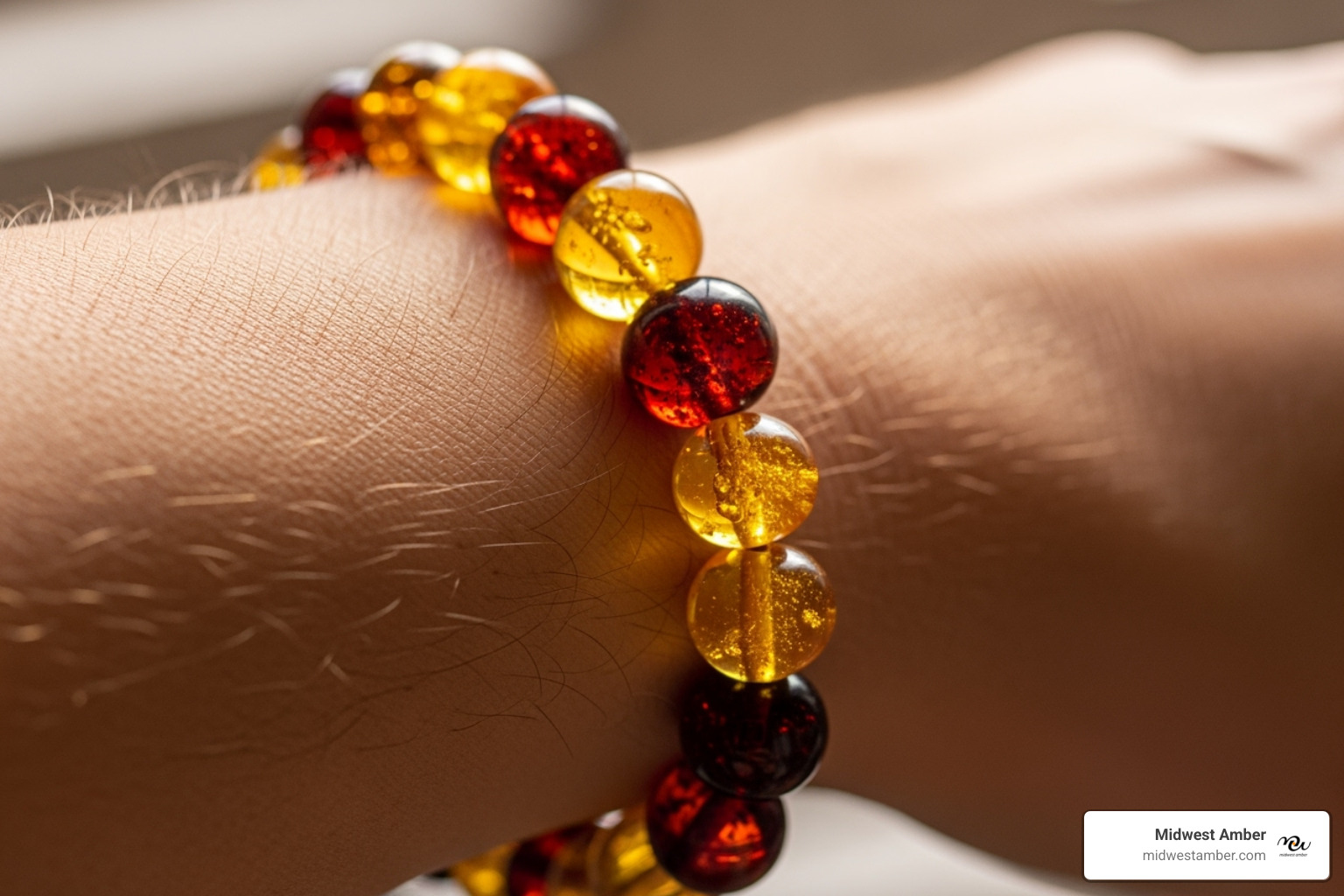
Frequently Asked Questions about Amber Bracelet Safety
We've covered a lot of ground, and I know it can feel overwhelming when you're trying to make the best choices for your family. Let's address the most pressing questions parents and adults ask us about amber bracelet safety.
So, are amber bracelets safe for teething babies?
Are amber bracelets safe for babies? The answer is a clear and definitive no. I wish I could give you a different answer, especially knowing how desperately parents want to help their little ones through teething discomfort.
The American Academy of Pediatrics and the FDA have made their position crystal clear after reviewing real cases of injury and death. The risks of choking on small beads, strangulation from cords, and bacterial infections are not theoretical concerns—they're documented dangers that have led to tragic outcomes.
As someone who has spent over two decades working with amber, I understand the appeal of these products. They look harmless, even beautiful. But when it comes to infants and children under three, the documented risks are simply too severe. No unproven benefit is worth risking your child's life.
Does science support the healing claims of amber?
Here's where I need to be completely honest with you: the science just isn't there. The core claim that amber bracelets are safe and effective relies on succinic acid being released at body temperature and absorbed through the skin. Research has consistently shown this doesn't happen.
Amber needs to reach around 200°C (392°F) to release succinic acid—that's hot enough to cause severe burns. Your baby's skin temperature of 98.6°F simply can't trigger this release. Even if it could, there's no scientific evidence that succinic acid can be absorbed through the skin in any meaningful way.
Any improvements parents notice are likely due to the placebo effect or simply the natural ebb and flow of teething symptoms. I know that's disappointing to hear, but as someone committed to providing authentic information along with authentic amber, I believe you deserve the truth.
How can I choose a safe and authentic amber bracelet for an adult?
For adults wondering are amber bracelets safe, the answer is much more reassuring. When you're not dealing with the choking and strangulation risks that affect infants, amber jewelry becomes a matter of quality and personal preference.
Focus on reputable sellers who can provide certified authenticity. At Midwest Amber, our 20+ years of experience and direct relationships with suppliers in Poland and Lithuania mean you're getting genuine Baltic amber, not plastic imitations or treated materials.
Ensure proper construction by looking for well-strung beads and secure clasps. Our handcrafted pieces are built to last with attention to both beauty and durability. Choose the right fit—your bracelet should be comfortable without being too tight or so loose it catches on everything.
Consider ethical sourcing as part of your decision. We're committed to transparent practices from the Baltic mines to your jewelry box, ensuring you can feel good about your purchase on multiple levels.
For adults, amber bracelets are primarily about enjoying the natural beauty of this ancient material. While the healing claims aren't scientifically supported, there's nothing wrong with appreciating amber for its aesthetic appeal and the connection to nature it represents.
Conclusion: Making an Informed and Safe Choice
When we ask "are amber bracelets safe," the answer really comes down to one crucial factor: who's wearing them. The evidence is crystal clear when it comes to our most vulnerable family members.
For infants and young children, the answer is an unequivocal no. The medical community has spoken with one unified voice - from the American Academy of Pediatrics to the FDA - warning parents about the serious dangers these products pose. The risks of choking on small beads, strangulation from cords, and bacterial infections aren't just theoretical concerns. They're documented realities that have led to tragic injuries and deaths.
As much as we all want natural solutions for our teething babies, the unproven benefits simply cannot justify these very real, life-threatening risks. The science behind the healing claims has been thoroughly debunked, leaving us with products that offer no genuine relief but carry enormous danger.
For adults, however, the story is entirely different. When properly made and worn responsibly, amber jewelry poses minimal safety risks. If you're drawn to the warm beauty and ancient history of Baltic amber, wearing an amber bracelet becomes a matter of personal preference and aesthetic choice.
At Midwest Amber, we've spent over 20 years perfecting our craft and building relationships with ethical suppliers in Poland and Lithuania. Our commitment goes beyond just selling beautiful jewelry - we're dedicated to providing 100% natural, certified authentic Baltic amber that meets the highest quality standards. Every piece in our collection is handcrafted with care, ensuring both beauty and durability.
We believe in empowering our customers with honest, evidence-based information. When it comes to children's safety, there's simply no room for compromise. But for adults who appreciate the timeless elegance of genuine amber, we're here to help you find pieces that bring joy for years to come.
Ready to explore authentic Baltic amber? Find the perfect piece for your collection with our comprehensive bracelet bliss guide, where quality, authenticity, and your satisfaction are always our top priorities.




Leave a comment
This site is protected by hCaptcha and the hCaptcha Privacy Policy and Terms of Service apply.